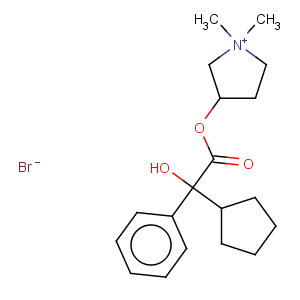Title: Glycopyrrolate
CAS Registry Number: 596-51-0
CAS Name: 3-[(Cyclopentylhydroxyphenylacetyl)oxy]-1,1-dimethylpyrrolidinium bromide
Synonyms: 3-hydroxy-1,1-dimethylpyrrolidinium bromide a-cyclopentylmandelate; a-cyclopentylmandelic acid ester with 3-hydroxy-1,1-dimethylpyrrolidinium bromide; 1-methyl-3-pyrrolidyl a-cyclopentylmandelate methobromide; 1-methyl-3-pyrrolidyl a-phenyl-a-cyclopentylglycolate methobromide; 3-(2-phenyl-2-cyclopentylglycoloyloxy)-1,1-dimethylpyrrolidinium bromide; glycopyrronium bromide
Manufacturers' Codes: AHR-504
Trademarks: Nodapton; Robanul; Robinul (Robins); Tarodyl; Tarodyn
Molecular Formula: C19H28BrNO3
Molecular Weight: 398.33
Percent Composition: C 57.29%, H 7.09%, Br 20.06%, N 3.52%, O 12.05%
Literature References: Synthetic, quaternary ammonium anticholinergic. Prepn: Franko, Lunsford,
J. Med. Pharm. Chem. 2, 523 (1960); Lunsford,
US 2956062 (1960 to A. H. Robins). Pharmacodynamics: E. Kaltiala
et al., J. Pharm. Pharmacol. 26, 352 (1974). Toxicology: B. V. Franko
et al., Toxicol. Appl. Pharmacol. 17, 361 (1970). Clinical comparison with atropine in anaesthetic practice: F. Kongsrud, S. Sponheim,
Acta Anaesthesiol. Scand. 26, 620 (1982); A. I. Webb, R. M. McMurphy,
Am. J. Vet. Res. 48, 1733 (1987); B. V. G. Malling
et al., Br. J. Anaesth. 60, 426 (1988). Brief review of pharmacology and clinical use: R. K. Mirakhur, J. W. Dundee,
Anaesthesia 38, 1195-1204 (1983).
Properties: White crystals from butanone, mp 193.2-194.5°. Sol in water. LD50 (72 hr.) in female mice, female rats (mg/kg): 107, 196 i.p.; in male rats (mg/kg): 1150 orally (Franko).
Melting point: mp 193.2-194.5°
Toxicity data: LD50 (72 hr.) in female mice, female rats (mg/kg): 107, 196 i.p.; in male rats (mg/kg): 1150 orally (Franko)
Therap-Cat: Antispasmodic; preanesthetic medicant.
Therap-Cat-Vet: Preanesthetic medicant.
Keywords: Antimuscarinic; Antispasmodic.

